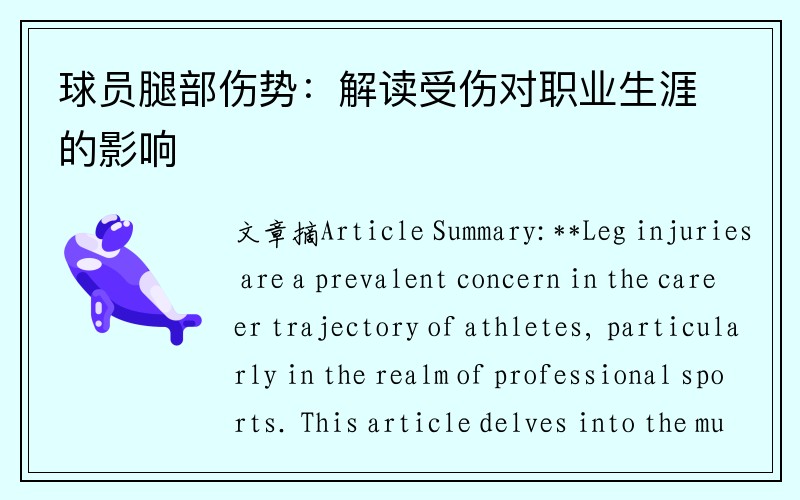球员腿部伤势:解读受伤对职业生涯的影响
文章摘Article Summary:**
Leg injuries are a prevalent concern in the career trajectory of athletes, particularly in the realm of professional sports. This article delves into the multifaceted impacts of leg injuries on an athlete's professional career. It examines four key aspects: the physiological ramifications, psychological challenges, career longevity implications, and the role of rehabilitation in recovery. Each aspect is explored in depth, shedding light on the complexities athletes face when navigating leg injuries. By dissecting these facets, this article aims to provide a comprehensive understanding of how leg injuries can shape the trajectory of a professional athlete's career.
**1. Physiological Ramifications**
Leg injuries encompass a spectrum of physiological complexities, ranging from minor strains to severe ligament tears and fractures. These injuries can compromise an athlete's mobility, strength, and agility, directly impacting their performance on the field or court. Furthermore, the rehabilitation process often entails rigorous physical therapy and prolonged rest periods to facilitate tissue healing and restore function.
Moreover, the risk of reinjury looms large, particularly in high-impact sports where athletes subject their bodies to repetitive stress. Chronic conditions such as tendonitis or stress fractures can develop, necessitating ongoing management strategies to mitigate their effects on performance and career longevity.
Additionally, the biomechanical alterations resulting from a leg injury may lead to compensatory movements, predisposing athletes to secondary injuries in other musculoskeletal regions. Thus, a thorough understanding of the physiological ramifications is imperative for devising comprehensive treatment and prevention protocols.
**2. Psychological Challenges**
Beyond the physical toll, leg injuries can exact a profound psychological toll on athletes, disrupting their mental well-being and confidence. The sudden loss of athletic prowess and the uncertainty surrounding recovery timelines can induce feelings of frustration, anxiety, and depression.
Moreover, athletes often grapple with the fear of not regaining their pre-injury form or facing premature retirement due to persistent physical limitations. This psychological distress can impede the rehabilitation process and hinder optimal recovery outcomes.
Furthermore, the social isolation resulting from being sidelined from team activities can exacerbate feelings of loneliness and alienation, highlighting the importance of providing comprehensive psychosocial support to injured athletes.
**3. Career Longevity Implications**
Leg injuries pose significant ramifications for the long-term viability of an athlete's career, with potential repercussions extending far beyond the immediate season. A prolonged absence from competition can disrupt the athlete's rhythm and detract from their marketability, impacting endorsement deals and sponsorship opportunities.
Furthermore, recurring injuries may erode the athlete's reputation for reliability and durability, diminishing their appeal to prospective teams and franchises. In a highly competitive sports landscape, maintaining peak physical condition is paramount for sustaining a lucrative and enduring career.
Moreover, the cumulative effects of multiple injuries can hasten the decline phase of an athlete's career, necessitating strategic career transitions and post-retirement planning to ensure financial stability and personal fulfillment.
**4. Role of Rehabilitation**
Rehabilitation plays a pivotal role in mitigating the adverse effects of leg injuries and facilitating the athlete's return to peak performance. A multidisciplinary approach, involving sports medicine physicians, physical therapists, and strength and conditioning specialists, is essential for crafting individualized rehabilitation protocols.
Emphasis is placed on restoring range of motion, muscular strength, and neuromuscular control while minimizing the risk of reinjury through progressive loading and biomechanical analysis. Additionally, psychological interventions, such as cognitive-behavioral therapy and stress management techniques, are integrated to address the emotional toll of the injury.
爱游戏体育官网
Furthermore, a gradual reintroduction to sport-specific activities and functional training drills is employed to rebuild confidence and enhance performance readiness. Comprehensive monitoring and periodic reassessments ensure that the athlete's rehabilitation trajectory aligns with their recovery goals and timeline.
**Summary:**
In conclusion, leg injuries exert a multifaceted influence on the careers of professional athletes, encompassing physiological, psychological, and career-related dimensions. By comprehensively evaluating these aspects, stakeholders can implement targeted strategies to optimize rehabilitation outcomes and mitigate the long-term consequences of injuries. Despite the formidable challenges posed by leg injuries, with proper medical care, rehabilitative interventions, and psychological support, athletes can navigate adversity and forge resilient career trajectories.
斯科拉里:传奇球员生涯的辉煌征程
斯科拉里:传奇球员生涯的辉煌征程,是一个充满荣耀与挑战的传奇。从他的球员时代到后来的教练生涯,斯科拉里都展现了超凡的天赋和无与伦比的领导力。本文将从他的早期职业生涯、国家队征战、国际赛场辉煌以及退役后的影响力四个方面来探讨斯科拉里的传奇之旅。1、早期职业生涯斯科拉里的足球之路始于小球队,但他的天赋很...
探寻西班牙足球明星的辉煌之路
文章摘要:本文将深入探寻西班牙足球明星的辉煌之路。首先,我们将回顾西班牙足球的历史及其对世界足球的影响。然后,我们将探讨西班牙足球明星在职业生涯中的成长与发展,包括他们在俱乐部和国家队的表现。接着,我们将分析西班牙足球明星在赛场上的技术特点和战术角色。最后,我们将探讨西班牙足球明星对于球迷和足球文化...